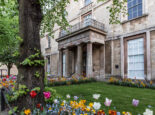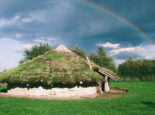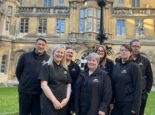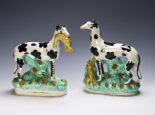Thomas Cook: from temperance to travel triumph
[prev] …survives today, with any profits the trust makes being given out as educational grants. The works of art were bequeathed to the nation. So all of that comes from the profits of the company, all derived from travel.’
Wagons-Lits operated the company during the 1930s. ‘Those were difficult economic times; a lot of people were made redundant, but then things started to pick up again in 1934/35. And then everything comes to a big, crunching halt again in 1939.’ Unlike during the First World War, the Second completely stopped people from travelling and with its parent company now in enemy hands, Thomas Cook found itself in danger of going bust on its centenary. ‘So, the Government intervened, basically deciding that the brand of Thomas Cook was too well-known and important to just disappear. The four mainline railway companies were persuaded to set up a holding company and they become the shareholders.’ That meant that, when the railways were nationalised to become British Railways in 1948, Thomas Cook became state-owned. It’s an aspect of the firm’s history that very few people realise, despite the government ownership continuing right the way through until 1972.
Into the modern era, via Peterborough
This era saw a contraction of the company outside Britain, apart from those branches in the core markets of Egypt and India. Most of the European offices reverted to Wagons-Lits as part of a postwar compensation agreement, resulting in the name practically disappearing from the Continent except as a traveller’s cheque brand. ‘The Continental businesses we have today are not descendants of the Thomas Cook outlets of the 19th and early-20th century,’ Paul clarifies. ‘They’re all from 21st-century acquisitions and mergers. I’ve had managers come over who were amazed to find out that Thomas Cook had offices in their countries before.’ However, in its British homeland, Thomas Cook initially boomed thanks to the rise in post-war travel. It set up a business travel service and also refurbished its holiday camp at Prestatyn in north Wales. Profits exceeded £1 million for the first time in 1965, but this was in the face of much increased competition from new travel firms offering cheaper package deals to newly popular destinations such as Spain.
‘There were 11 places considered… In the end, it came down to Swindon and Peterborough’
As the 1960s progressed, the elder statesman of tourism began to lose market share to the new kids on the block. Thomas Cook was ‘de-nationalised’ in 1972, when it was bought by a consortium of the Midland Bank, Trust House Forte and the AA (although the Midland eventually took over completely). It ushered in a period of radical reorganisation. ‘The company is examined very closely and the retail network expands,’ says Paul. ‘But they sell off noncore things such as the shipping yard in Cairo and the holiday camp at Prestatyn. It also brought about the end of the uniformed men; the original reps introduced by John in the late-19th century who were positioned at all the main stations and ports around the world to assist anybody travelling with a Cook’s ticket. They were effectively a living guide book and were around for almost a century.’
There was also the move of the administrative headquarters to Peterborough from more expensive London. ‘There were 11 places considered at first but the criteria ultimately was that it had to be within an hour’s commute of London and somewhere where they could buy or build a new head office quite cheaply. In the end, it came down to Swindon and Peterborough; presumably the Peterborough Development Corporation offered a better deal than its Swindon equivalent. We’ve got brochures in the archive encouraging staff to move, basically selling the city to those who’d probably never been to or even heard of Peterborough.’
The Thomas Cook site in Bretton is now responsible for all of the UK operations and has its own call centre
Thomas Cook started building at Thorpe Wood from 1974, with some company departments moving up from London to occupy other locations in the city while construction continued. The building opened fully in May 1977, with the inaugural ceremony performed by Princess Alexandra. ‘At that time there were about 1,500 people, although only about a third physically relocated. All the rest were recruited locally.’ The present Thomas Cook site in Bretton was originally an overspill location for employees who couldn’t be accommodated at Thorpe Wood, but changed name from the Merlin Business Park to the Thomas Cook Business Park when the company occupied more than half of it and decided to buy the freehold after Travelex took over Thorpe Wood in 2001. It is now responsible for all of the UK operations and has its own call centre.
Thomas Cook weathered the recession of the 1970s better than many of its upstart rivals, several of which disappeared. During the 1980s, it focused on expansion again, taking over Rankin Kuhn Travel, Frames, Blue Sky and Four Corners. This helped increase its high street presence even further, as did the 1990s acquisitions of Sunworld, Time Off and Flying Colours. Ownership of Thomas Cook passed to Westdeutsche Landesbank (WestLB), Germany’s third largest bank, in 1992, in partnership with LTU Group, that country’s largest charter airline. Less than a decade later during 2001, the company was purchased by C&N Touristic AG, one of Germany’s largest travel groups. Within a few months, C&N had changed its name to Thomas Cook AG. ‘This meant that the Thomas Cook brand could be rolled out across Europe again, as well as Egypt, India and Canada,’ explains Paul. Only a couple of years later, Thomas Cook Airlines was launched in the UK. There were further big changes in 2007, when Thomas Cook AG and the Scandinavian-based My Travel Group PLC merged to form the Thomas Cook Group PLC, and in 2011 when the company was amalgamated with the Co-operative Group’s travel offices, creating the UK’s largest retail travel network.
‘We are still trading under Thomas Cook’s name and still selling and packaging leisure travel as he was in the 1840s’
The recent economic recession wasn’t that happy a time for Thomas Cook, but, as it has done several times before during its lengthy existence, it weathered the financial storm. It now has sales of £9 billion and more than 20 million customers. Over 27,000 people are employed in 17 countries, with around a thousand of those in Peterborough. Across the UK, there are approximately 850 high street branches, although Thomas Cook has also worked hard on its internet retail presence. It’s a largely unparalleled success story that, in two years’ time, will see the company celebrate its 175th birthday. This is a milestone that none of its rivals can claim and, to be honest, none will ever be likely to achieve either because of the way modern business works. ‘We are still trading under Thomas Cook’s name and still selling and packaging leisure travel as he was in the 1840s,’ smiles Paul. ‘And to me, that’s significant.’ No doubt Thomas Cook and John Mason Cook would be very proud. Although the former probably wouldn’t raise a glass to toast the triumph…















